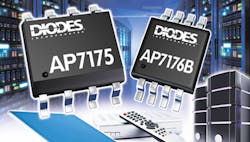LDO Linear Regulators Boost Drive Capability
The AP7175 and AP7176B, from Diodes Incorporated, are ultra low dropout linear regulators capable of delivering a continuous 3.0 A output for a dropout voltage of 0.23 mV. With maximum input voltages of 3.65 V and 5.5 V, respectively, they provide an adjustable output voltage suitable for high-efficiency systems in a range of products including notebooks, PCs and set-top boxes. To meet the sequencing requirements of FPGAs, DSPs and other digital devices, both regulators provide an enable input and power-good output. The regulators integrate a soft-start function that reduces in-rush current during start and the on-board current limit. Short-circuit and thermal shutdown protection functions ensure that connected loads are fully protected against any possible current excesses. Both devices are provided in the reduced thermal impedance SO-8EP and smaller form factor MSOP-8EP exposed pad packages. Reducing the junction-to-case temperature differential, these packages enable high load currents over their -40ºC to +85ºC ambient temperature range. The AP7175 and AP7176B LDO linear regulators are priced at $0.15 each/1k quantities.
